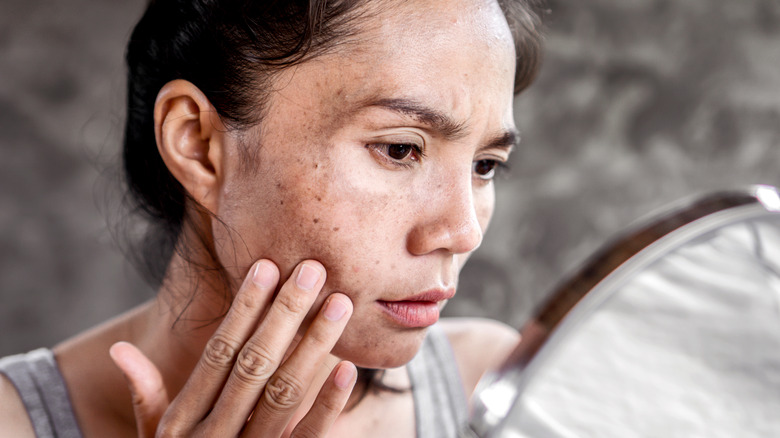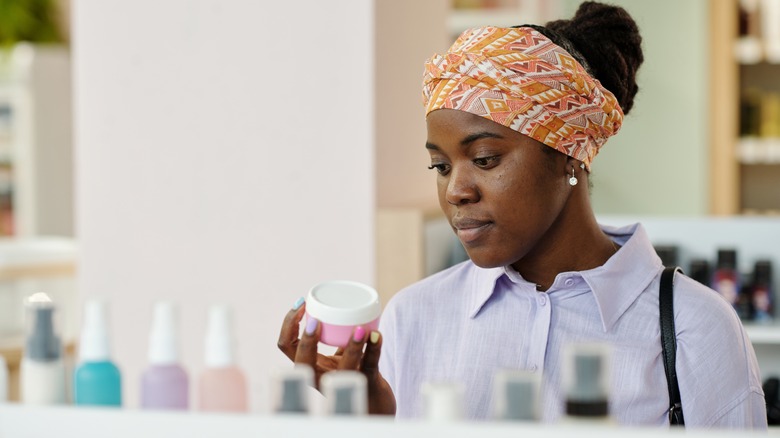Beauty Routine Leaving Your Skin Stinging? Here's What You Need To Know
The skincare world can be overwhelming. There's serums, creams, retinols, gels, face masks, lotions, and cleansers, products for exfoliating, plumping, brightening, smoothing, firming, recovering, and strengthening. There's three-step routines and ones with seven steps and with ten steps. Then even once you've found a skincare routine that works for you, over time, your skincare routine will have to change. And then there's adding in being a conscious shopper when it comes to beauty products to avoid things that aren't good for you and aren't good for the planet. It's a lot to take in.
But it is worth it to take the time to figure out a beauty routine that works for you, per The New York Times. And it can take time to fine tune a beauty routine: swapping in a new product may not show any new results for upwards of a month to six weeks, according to Marie Claire. So be patient as you try out new skincare products, and definitely be on the look out for any negative skin reactions to your beauty products. One possible adverse side effect could be a stinging sensation as you put on a product, and stinging doesn't mean that the product is just working really well. Here's what you need to know about why your skin may sting when using certain products and how to avoid it.
Understand the layers of your skin to help keep them healthy
If skincare products that you have used in the past without any stinging or adverse reactions begin to become uncomfortable and painful to use, it may be that your skin has become damaged. The top of the three layers of your skin, the epidermis, is further divided into five layers; the topmost of which is the stratum corneum, as noted by Coveteur. Dermatologist Melissa Kanchanapoomi Levin explained to Coveteur that the layer works "as a barrier against multiple stressors on the skin by regulating the balance of water." And within that stratum corneum are even more layers: the "microbiome, acid mantle, and lipid barrier," as reported by Sunday Edit.
The stratum corneum can become "compromised" due to a number of factors, including dehydration, dry environment, over-exfoliation, and excessive use of chemical treatments, and without its natural barrier, skin can sting and turn red when you put on certain products, per Martha Stewart. Restoring the health of that skin barrier means lessening the chance of a stinging reaction to beauty products. It involves re-balancing your microbiome and your skin's pH in the acid mantle; there are products like those by GladSkin designed specifically to help keep the microbiome healthy. Start using milder formulas without any acids, keep skin moisturized, and focus on building your skin's healthy barrier back before integrating more powerful products again, according to InStyle.
Know the difference between a sting and a tingle
Some beauty products include ingredients inherently more likely to cause a tingling or prickling feeling, according to Advanced Dermatology & Skin Cancer Associates. Basically, you can expect potential tingling from your skincare if it's designed to bring down the pH of your skin — think retinol, glycolic acid, salicylic acid, and vitamin C, via Renée Rouleau. Other ingredients that could cause a tingling sensation are eucalyptus, menthol, and peppermint. Even if you don't get any kind of feeling upon application with those ingredients, that doesn't mean the product isn't working. Always follow the usage guidelines on the package; you can always build up to a stronger concentration over time, per Refinery29.
If you do feel any tingling, it should fade quickly and not leave skin red or inflamed. If your skin is prickling, feels hot and/or looks red, it's time to wash off the product with cool water — you've moved into a more dangerous territory. Make a note of what product may be the culprit and its active ingredient; if you're not sure, check in with a dermatologist or your doctor. If you get a stinging response to a prescription skincare product, talk to the prescriber to see if it's an expected response that will lessen over time or if your skin needs a different product, as noted by The Dose.
Don't double up on active ingredients
Another reason you might feel stinging during your beauty routine is if you've chosen products with active ingredients that don't complement each other. Retinols and glycolic acids used together can increase the chance for skin irritation, in turn harming that skin barrier and lead towards stinging, per Everyday Health. Retinols and salicylic acid together can dry out skin, and if you use products with the same active ingredient, you don't get double the benefits, particularly with acids. The double dose can lead to, you guessed it, skin drying out and becoming irritated, according to Style Story.
It could also be that a new product you've added to your routine was chosen without consideration for your skin type, and understanding the type of skin you have is vital for creating an ideal, healthy beauty routine. The American Academy of Dermatology Association categorizes skin into five categories: normal, dry, oily, combination, and sensitive. Fun twist, the first four skin types can also be sensitive skin, and sensitive skin is more prone overall to having a stinging reaction to beauty products. You may know you have sensitive skin if you get a rash or irritation from things like scented laundry detergents, and dry skin is more susceptible to also being sensitive.
Know what type of skin you have to choose the right products
If you're not sure which of the four main skin types you have, CeraVe has two options for finding out. For both, start by washing your face, making sure to use "a gentle cleanser." Then after drying your face and waiting 30 minutes, you can either inspect it carefully or dab it with blotting sheets, using different ones for your forehead, cheeks, nose, and chin. If, upon looking at your face, it's shiny all over, that points towards having oily skin. If it's oily on your T-zone (forehead, nose, and chin) but not elsewhere, that's probably combination skin. If it's flaky, that's a sign of having dry skin, and if it's neither super shiny nor dry — the Goldilocks of skin — it's probably normal skin.
And if you go for the blotting sheet method, if you see oil on all the sheets, that's oily skin. Oil on no sheets means dry skin; oil just from the T-zone is combination skin. Knowing your skin type and what products are right for it, whether your skin is sensitive in general, what ingredients lend themselves to a physical reaction, and how to keep your skin barrier healthy should mean that skin stinging becomes a thing of the past.




